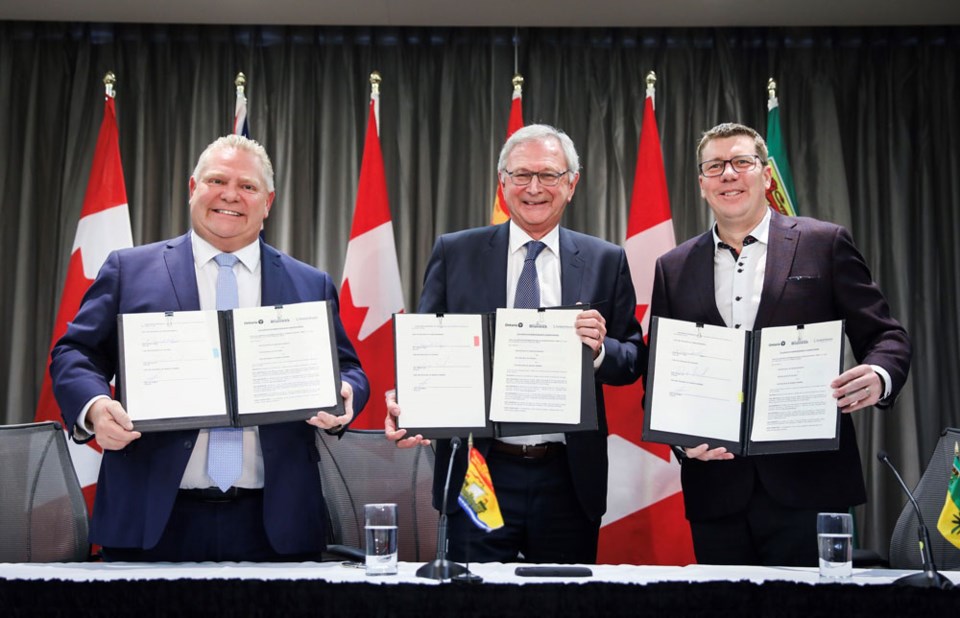After months of broadly hinting Saskatchewan would be getting into nuclear power production, as well as a reference in the recent speech from the throne, Premier Scott Moe has taken the first concrete action in that direction.
Indeed, his statements at a press conference suggest Saskatchewan could go into nuclear power for electrical power generation in the coming years, possibly replacing both coal and natural gas further down the road.
While in Toronto on Dec. 1, Moe signed a memorandum of understanding (MOU) with Ontario and New Brunswick with regards to the development of small modular reactors (SMRs).
Moe, Ontario Premier Doug Ford and New Brunswick Premier Blaine Higgs released a joint statement after the announcement.
“Ontario, Saskatchewan and New Brunswick agreed today to work together to explore new, cutting-edge technology in nuclear power generation to provide carbon-free, affordable, reliable, and safe energy, while helping us unlock economic potential across Canada, including rural and remote regions.
“We have signed a memorandum of understanding (MOU), committing to collaborate on the development and deployment of innovative, versatile and scalable nuclear reactors, known as small modular reactors (SMRs), right here in Canada.
“SMRs could generate clean and low-cost energy for both on-grid and off-grid communities, connect more remote and rural areas of our province, and benefit energy-intensive industries, including the mining and manufacturing sectors. It could also drive economic growth and export opportunities as these technologies are further adopted across the country and around the world.
“Our governments support a collaborative approach to reducing emissions and growing the economy in a way that meets the specific needs and economic priorities of each province. We look forward to continuing to work together on innovative energy solutions and creating the best business environment to attract jobs and growth in regions right across the country.”
During the press conference, Moe noted that Saskatchewan is committed to reduce emissions in the electricity sector by 40 per cent below 2005 levels before 2030.
Leading off the press conference he said, “We believe we can do this without unnecessary taxes that burden families, businesses. Taxes that really do little in reducing emissions directly. Saskatchewan’s plan of Prairie Resilience achieves our emissions reduction through targeted investments in innovative technology in our Canadian industries, without impacting our jobs, or impacting the Saskatchewan economy.”
He noted that implementing small modular reactors will provide meaningful action in reducing carbon emissions in electricity production while providing affordable, baseload power to communities and industries.
Estevan and Coronach have been under considerable angst over the future of coal-fired power near those communities, and Moe suggested that places that already have power generation transmission infrastructure might be potential sites for SMRs. He said, “In addition to providing reliable, sustainable and affordable baseload power supply, this technology has the potential of creating high quality jobs and local economic development opportunities in communities where existing transmission infrastructure already exists, or, further, in rural and remote communities that currently rely on higher emissions power production.”
Saskatchewan, in particular, has been under pressure to reduce its reliance on coal-fired power generation as the federal government has pushed to phase out coal-fired power nationwide by 2030 in an effort to reduce greenhouse gas emissions. Ontario has already phased it out under its previous Liberal government, and Alberta was put on that path by its previous NDP government. New Brunswick and Nova Scotia still rely on coal for some of their power production.
Use of nuclear power would eliminate carbon dioxide emissions versus either coal or natural gas-fired power generation which it replaces.
Moe’s statement hinted that Saskatchewan could go heavily into nuclear power. He noted that Saskatchewan could reduce its power generation greenhouse gas emissions by adding, through carbon capture and storage, to its coal-fired generators, “or replacing those generators with combined cycle natural gas generation.”
Moe said: “By incorporating small modular reactor technology, in place of natural gas, or in place of coal generation with carbon capture and storage, that 40 per cent reduction target that I mentioned would actually move to 70 per cent emissions reductions by 2030, 80 per cent by 2040, and a complete 100 per cent elimination of Saskatchewan’s electrical generation emissions by 2050. This is positive for Saskatchewan, this is positive, for Canada, and it’s taking real action in addressing global climate change.”
One option to reduce carbon dioxide emissions has been “clean coal.” While Saskatchewan was the first jurisdiction in Canada to implement a commercial-scale carbon capture and storage (CCS) system on a coal-fired generating unit, at the Boundary Dam Power Station’s Unit 3, the concept has not caught on elsewhere. Even within Saskatchewan, SaskPower has also chosen not to implement CCS on Boundary Dam Units 4 and 5. An equivalency agreement with the federal government reached in 2019 allowed the life of those units to be extended a few more years, otherwise federal regulations would have required them to shut down by the end of 2019.
A study put out in late 2018 by the Regina-based, SaskPower-affiliated International CCS Knowledge Centre indicated a second generation of CCS could be implemented at Shand Power Station. The report’s summary indicated that, compared to Boundary Dam Unit 3, “a CCS system at Shand could see capture capital cost reductions of 67 per cent per tonne of carbon dioxide captured as well as 92 per cent in potential savings to power plant integration capital cost.”
The Saskatchewan government has not made any decisions on whether to implement CCS on its remaining coal fleet of Boundary Dam Unit 6, the Shand Power Station and the Poplar River Power Station. Beyond the aforementioned hints, at this point, there has not been any definitive indication from the provincial government where potential small modular reactors would be placed, should they be built.




